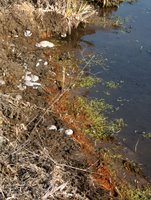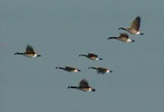Redox Cascade

This chart (click for a readable version) shows shows the cascading preference of electron acceptors needed to sustain microbial respiration. When a soil system runs out of oxygen, it relies on nitrate (denitrification) to accept the electrons freed by respiration, and so forth down the cascade. Not shown at the bottom of the cascade is the production of hydrogen from water, but then that is an extreme seldom achieved in nature. The units for Eh are millivolts, the standard measure of redox potential.
An equivalent measure of redox potential is pE. Just as pH is the negative log of the hydrion activity, pE is the negative log of electron activity (source). Soil pE and soil pH are equally important to predicting charge state of metals and nutrients. However, because measuring pH is relatively easier by far, and because knowing pH tells us volumes about expected pE, soil pE is a less discussed subject. It is important to bioremediation, industrial chemistry, and wetland science. Not a household term.
These two are more than a mirror pair, although mirroring is their most notable characteristic. When pH changes, pE must also change in response. The reverse is true also. In soil, that response departs from simple mirroring. So much so that it can seem to be two separate dances.
Soil pH and pE have different causes of change and different effective buffering agents. The term 'buffering' is replaced in a pE context - it is called poise. A stabilized soil pE system is referred to as a well poised system, differences in soil buffering versus soil poise account for the departure from 1:1 mirroring.
Now for the exciting stuff. To many of us, what makes soil different than geologic material is that it is in an excited state, excited mostly by solar energy as facilitated by living processes. Unlike soil pH, soil pE is directly influenced by these energy fluxes.
The most influential cause of changes in soil pE is metabolic respiration aka oxidation. Oxidation doesn't necessarily involve oxygen. Oxidation does necessarily involve shedding an electron. Thus, respiring living systems lower the pE of a soil system, and with pE in the dance lead, pH must follow. Wetlands are low pE systems, wetlands with hydrogen sulphide odors are very low pE systems. Common dryland agricultural crops, like wheat, cannot abide low pE systems. Rice is adapted to low pE conditions.
A well recognized soil buffering agent is lime, which buffers a soil to about pH 8.2. The major agent of soil poise is iron. By all rights, the chart should show iron as having the longest duration horizontal line: there is a vast amount of iron in soil compared to nitrate and manganese. However soil manganese, although far less abundant than iron, plays a more important, more dynamic role in most soil systems.
One soil scientist, Richmond Bartlett, was so taken with the importance of manganese in this regard that he opened his chapter on manganese in a 1995 soil chemistry text (1995, Environmental Soil Chemistry, edited by Don Sparks) with the phrase “We all should fall upon our knees and sing out praise for manganese” Richmond Bartlett goes on to describe the role of manganese in terms that nearly describe a catalyst. Mn is not consumed, and the capacity for metabolic respiration increases in its presence.
This is sheer speculation on my part: from my view through the knothole, the nearly catalytic nature of traces of Mn is a finessing touch that makes bio-char the wonderful soil reef it is. It is a fine point, and one hardly worth mentioning considering the much more important issues that need working out in our pursuit of Wim Sombroek's vision for terra preta nova.
Expanded from information originally posted on the terra preta forum.







